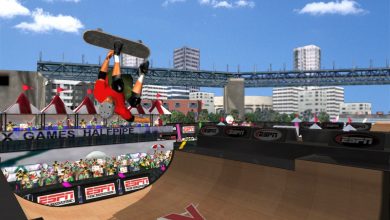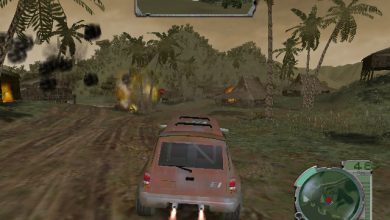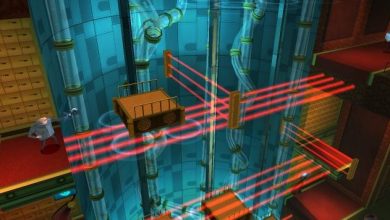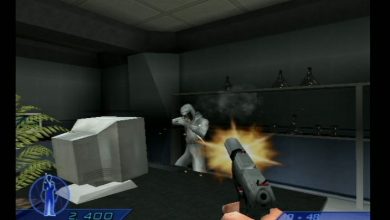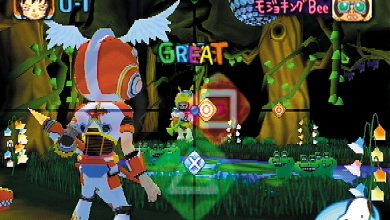Shinobi Review
Almost cuts the mustard
Ninjas are cool. I don’t need to tell you that. And games featuring them have the potential to be really cool. Sega realized this very early in their Genesis days, and put out a little game called Shinobi to much acclaim. And now they have decided to remake the classic for a new generation, and the results are a little mixed. The pacing is certainly blistering, and the new main character is pretty cool, but there are enough problems in the design that keep this game from being a true classic.
Content Index
Story
Woof. Imagine if you will a 1930’s era newspaper with the headline, “Ninja saves Neo-Tokyo from ancient demon resurrection!!!!!!!” in big bold print across the top. That’s about all you need to know. Better than a lot of action games (Devil May Cry, Splinter Cell, Rygar), but nothing to tout really.
Gameplay
Shinobi is, and has always been, all about speed. I could have seen Sega taking the stealth ninja route with the game, but they instead decided to make it a non-stop action game. Hotsuma has the ability to dash, double jump, and run across the sides of walls, and his offensive maneuvers consist of slashing and throwing shirukins to stun enemies. Early in the game, Hotsuma finds out that his ancestral sword is actually the cursed demon sword, Akuji, and that it wants to eat his soul. Now if Hotsuma can continuously feed Akuji the souls of his enemies, he can temporarily sate it’s hunger. But if he goes too long without killing an enemy, the Akuji meter will deplete, and it will start to feed on Hotsuma’s life gauge. So in a sense, the entire game runs on an organic timer. There is no set time limit for each stage, but if you go too long without a fatality, you will start to die. This keeps the pace pretty quick, though it isn’t really conductive to exploration. Check out the lower level and die, or press on to the next portal and live; Not much of a choice really.
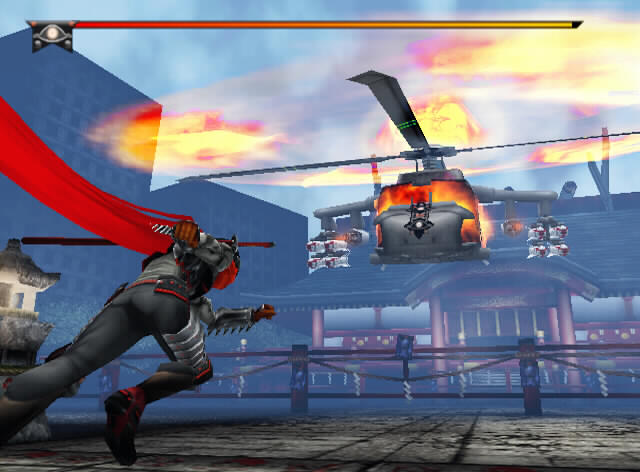
And in another effort to keep you on your toes, Hotsuma has the “Tate” gauge to worry about as well. Whenever Hotsuma encounters a group of baddies, a Tate bar will appear at the top-right part of the screen, with one icon for each enemy. As you kill enemies and fill up the gauge, your sword gets stronger and stronger, and if you can kill an entire group, you get to see a cool “finisher” cut-scene as well. When you slash an enemy, they simply freeze in place, but when you kill the last enemy in a group, the entire lot will fall to pieces all at once, while Hotsuma makes a cool little pose. Neat. But the trick to all of this is that the you only have a set amount of time to kill the next enemy in a string, and the Tate gauge will reset if you’re not quick enough (and Tate power-ups are not permanent. The effect only lasts for the duration of that battle). The Tate gauge is really the only thing preventing Shinobi from becoming a boring button masher; you always need to use discretion. Smaller enemies always surround huge, powerful enemies, and they are much easier to topple if you take out the little guys first and build up your power. And even when it is less obvious, you should really take the time to pick your mark in every battle. Taking out the weaker, flying, projectile-spewing enemies first will give Hotsuma the power and freedom he needs to kill regular ninjas in one hit.
Good times so far, but now for the bad stuff. Lessee…….. The camera sucks. And I usually don’t mind finicky cameras either. While every Kingdom Hearts review in the world mentioned the camera problems, I really had absolutely no trouble with it. And I’ve never much minded Sonic Adventure’s notoriously sticky camera either. But I have to admit that the camera in Shinobi is pretty bad, mostly because it’s so damn lazy. It will follow Hotsuma around the stage (barely) but it will never auto adjust for turns, and usually ends up in less than optimal positions during heated battles. Later in the game when Hotsuma must descend a series of control rooms, it becomes almost impossible to see down them. The same thing is true for ascending towers.
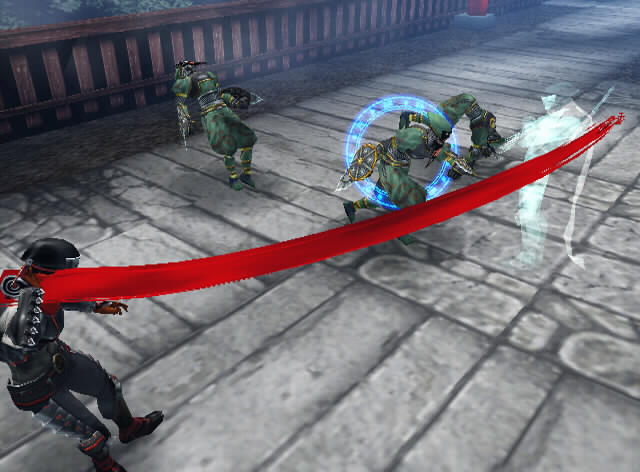 While the Tate function works well most of the time, it created its fair share of problems as well. Firstly, the lock-on function in Shinobi is very dim-witted. It has an uncanny ability to consistently target the enemy that is as far away as possible from Hotsuma. It wouldn’t normally be a big deal in most games, but it’s an absolute nightmare in Shinobi with the timed Tate gauge and such. I felt also that the Tate functionality really ruined most of the boss fights. The bosses were all well designed with clever patterns and personalities, but Sega made damn well sure that each could only be bested using the Tate gauge. Normal slashes do almost nothing, and each boss can only be killed by building up the gauge after killing their various underlings. No boss can withstand more than a few full Tate gauges worth of damage, and the vast majority of them go down with one. It would have been far more interesting if the Tate effect had been removed or at the very least underplayed during boss battles, forcing you to get in there and learn the patterns and attack-timing. As it stands, all of the fights tended to bleed together. Avoid avoid, avoid, until the small fries appear, and then just thwack the boss once. It’s a shame really.
While the Tate function works well most of the time, it created its fair share of problems as well. Firstly, the lock-on function in Shinobi is very dim-witted. It has an uncanny ability to consistently target the enemy that is as far away as possible from Hotsuma. It wouldn’t normally be a big deal in most games, but it’s an absolute nightmare in Shinobi with the timed Tate gauge and such. I felt also that the Tate functionality really ruined most of the boss fights. The bosses were all well designed with clever patterns and personalities, but Sega made damn well sure that each could only be bested using the Tate gauge. Normal slashes do almost nothing, and each boss can only be killed by building up the gauge after killing their various underlings. No boss can withstand more than a few full Tate gauges worth of damage, and the vast majority of them go down with one. It would have been far more interesting if the Tate effect had been removed or at the very least underplayed during boss battles, forcing you to get in there and learn the patterns and attack-timing. As it stands, all of the fights tended to bleed together. Avoid avoid, avoid, until the small fries appear, and then just thwack the boss once. It’s a shame really.
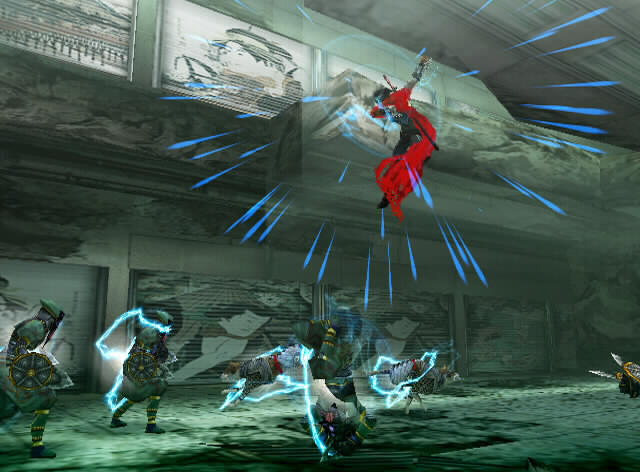
And let’s not forget the extreme frustration factor either. There are no mid-points, and Hotsuma doesn’t have lives either, so if you die during a stage, you have to play it from the beginning, regardless of how far you got. This really didn’t bother me until about level 6, when they started to introduce bottomless pits. Pure insanity. If I died 100 times in Shinobi, 85 of them were due to falling in pits (no thanks to the rotten camera I might add). The last boss of the game has also seemed to achieve an almost legendary level of difficulty (if we’re to believe the message board posts regarding him). I don’t know if he’s the hardest last boss I’ve ever faced, but he’s damn tough. All I can say is to learn his battle cries by heart, and to never give him a moment of breath. Now excessive pits I can whine about, but I refuse to ever site plain difficulty as a flaw. Just keep in mind though that beating Shinobi probably entails an above average constitution.
Graphics
Well Shinobi isn’t a bad looking game, but it isn’t great either. You’re certainly not going to see anything you haven’t seen before, but I suppose that it does look better than a lot of other PS2 games. The character models look pretty good, and some decent texture work can be found here and there as well. The environments are fairly detailed (if a bit repetitive), and there is never really any major slowdown. The only downside I could see was that some of the effects were pretty bland. Fire was represented with a series of orange blotches, and water was simply two animated blue textures running over a black background. On the other hand, Hotsuma’s scarf is simply amazing. This scarf is possibly one of the greatest pinnacles of human evolution. It’s a long, scarlet, flowing beast of an accessory that whips around the screen as Hotsuma dashes around. It sticks behind him for a split second afterwards too, as if Hotsuma is constantly being traced with a big red crayon. It also functions as an instant means of identification; you’ll never loose track of Hotsuma in a crowd of bad guys. So, while the graphics aren’t bad, and the scarf is pretty awesome, I’d still call the graphics competent more than anything else. Sega did what they had to do to make the game come to life, but added little flair above the average PS2 fare.
Sound
The tunes in the game are all based around ancient Japanese folk music. They really worked that koma-bue (crappy Japanese flute) to death! While this kind of music is all very appropriate for the theme and setting, it doesn’t really mesh well with the on-screen action. Shinobi is all about zipping around and slashing everything in sight as fast as possible, yet there are all these slow, melodic ballads playing in the background. Would it have killed them to insert a little techno here and there? Hell, I would have liked anything with a beat! Devil May Cry did a much better job of incorporating gothic, Victorian elegies with fast-paced combat music. The developers strayed a little here and there with some old-school tracks that sounded like they could have been composed for the genesis, but these really didn’t impress me either. They weren’t particularly well done, and it just seemed like a desperate attempt to strike some type of chord with older gamers. If you’re going to play the nostalgia chip, why not remix some previous Shinobi tunes? The fact that they used primitive source instruments doesn’t really achieve the same effect. Yeah it could remind you that Shinobi was originally a genesis game…….but so what? But as much as I’ve railed here, I can’t say that the music was flat out bad – just not really to my personal liking. Some fellows may dig it.
The sound effects are decent, but the voice acting is…..so-so. The actors can be divided into three groups: Ninjas, Villains, and women. The ninjas all sound pretty good, but bare in mind that they are rarely asked to do much more than gravely assess the situation. Things fall apart in the few scenes where Hotsuma and co. are asked to do anything beyond the stoic. The villains are all awful. They’re all stuck in various levels of Dr. Evil and/or Gargamel from The Smurfs. You want to take their lives away not to help Hotsuma save Japan, but simply to cease the endless flow of pain that emits from their mouth(s). And also, be it due to fate or coincidence, all of the women in the game are voiced by terrible, terrible actresses. Terrible. English voice acting = not so hot, but Sega has wisely added the option for a Japanese track, which is an absolute godsend. Given the setting, it’s really quite an appropriate choice. That’s really the only thing preventing a score under 5.0 in this category.
Replay Value
As we saw with Primal, a lot of people seem to be clocking Shinobi in a little short. While my game timer was a few hours shy of 10 at the end of the game, if I counted in deaths, continues, and restarts, my total game time would have probably been closer to 15 hours, which is much more respectful for an action title of this ilk. On the other hand, you might be a lot better (or a lot worse) Shinobi player than me, so your time might vary.
And once the main game is done, there’s still quite a bit to do. Each stage contains a set number of Oboro tokens, and you unlock bonus options as you collect them. You can unlock a movie viewer, art gallery, stage select, and eventually a couple secret characters, including a big blast from the past for old-school Shinobi fans. You can play through the game with these new characters (who play quite differently than Hotsuma) collect more tokens with them, and eventually unlock several new bonus stages. The nice thing about these bonus areas is that they don’t take place in areas that you’ve seen before. While it would have been easy to construct new levels using the assets from the previous stages, Sega went the extra mile, and made whole new themes for the bonus stages. One takes place in a creepy old parking garage, and another takes place under an abandoned freeway overlooking a bombed-out suburb. It’s really quite cool, and if you have the time, patience, and skills, they are worth the effort to unlock.
Now if you’re a crazy Shinobi fool, and the main game wasn’t challenging enough, there are tougher mountains to scale here as well. You are given a grade at the end of every stage based on Tate, item usage, and damage, and you can eventually unlock an absolutely insane “super” difficulty mode as well. Though, honestly, I’d wager that 95% of the people who play Shinobi will have more of their fill in the main game, and probably won’t even bother with the extra missions listed in the paragraph above, let alone these new challenges. The gameplay in Shinobi is just so brutal on so many levels…….. It’s not always a fun game to play. Though in the end, this is more of a straight gameplay problem; the developers added plenty of replay value for those who can stomach it.
In Closing
Playing Shinobi is a lot like winning a new Corvette that constantly smells like rotting cheese. Yeah you can cruise around town and wave to the honeys, but the car still always smells like rotting cheese. Don’t get me wrong – the car is hot – but………. Wouldn’t it have been nice to win one of the vettes that didn’t smell like rotting cheese? Shinobi can be fun, but it is also deeply flawed, and I hope that Sega does some serious tweaking with the sequel in upcoming months.

